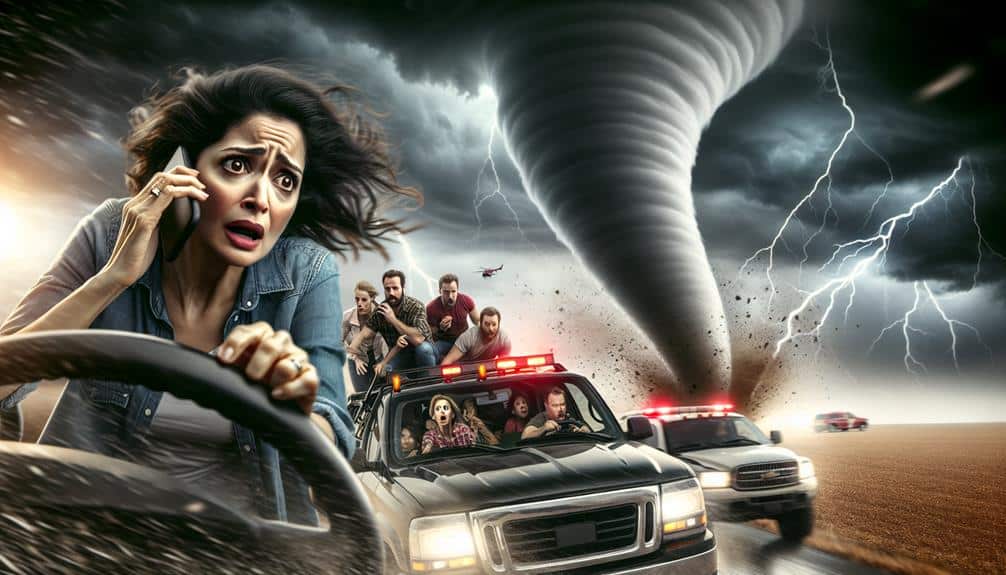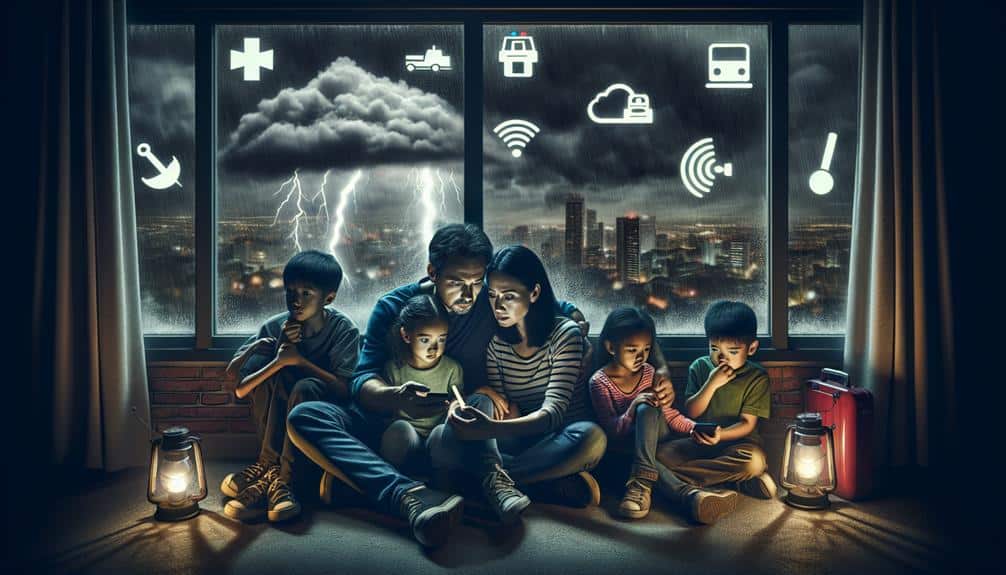When we're storm chasing, taking specific precautions in communication is crucial to guarantee safety and operational efficiency. We need to establish clear communication channels and designate specific roles within the team. Using reliable devices like satellite phones and VHF radios with backup power sources guarantees uninterrupted connectivity. Accurate information must be prioritized by cross-referencing data and avoiding misleading statements. Regular updates and coordination with local authorities are essential, along with preparing for signal loss and understanding emergency protocols. These steps enable us to make informed decisions and react promptly, enhancing both safety and mission success. Let's explore these measures further.
Key Points
- Ensure communication devices have backup power sources like battery backups and portable generators.
- Use reliable communication devices such as satellite phones and HF/VHF radios for uninterrupted communication.
- Establish clear roles and predefined communication protocols within the team for streamlined information sharing.
- Verify data from multiple respected meteorological sources to ensure accuracy before relaying information.
Establish Clear Communication Channels
When storm chasing, we must establish clear communication channels to guarantee real-time information flow and coordinate effectively.
First, implementing robust emergency protocols is crucial. These protocols should outline procedures for relaying critical information, such as storm position and intensity, to all team members promptly. We need to make sure that everyone understands these protocols and can execute them under pressure.
Local coordination plays a crucial role in maintaining situational awareness. By liaising with local authorities, weather stations, and emergency services, we can access essential data and updates that enhance our decision-making process. Establishing pre-arranged contact points with these entities ensures we're not left in the dark when the storm's behavior shifts unpredictably.
In addition, we should designate specific roles within our team to streamline communication. For instance, having a dedicated person responsible for monitoring weather updates while another focuses on navigation can prevent information overload and enhance operational efficiency.
Our communication channels must be resilient to disruptions; redundancy plans, such as backup communication methods, guarantee we remain connected even if primary systems fail.
Use Reliable Communication Devices
When we're out in the field, it's essential that we use reliable communication devices such as satellite phones and designated radio frequencies to guarantee consistent contact.
We'll also need to prepare backup power sources to avoid lapses in communication during critical moments.
Satellite Phones
Equipped with satellite phones, we guarantee uninterrupted communication, necessary for both safety and real-time data sharing during storm chasing. These devices excel where traditional cellular networks fail, ensuring we stay connected even in remote locations where the storm's impact is most critical. Satellite phones provide a direct link to emergency response teams, allowing us to report crucial situations instantly and receive timely assistance if needed.
Our ability to send and receive data in real-time is essential for accurate storm tracking and analysis. Satellite phones enable us to relay meteorological data, video feeds, and GPS coordinates without delay, enhancing our operational efficiency. This real-time communication is crucial for coordinating with other storm chasers and meteorological agencies, ensuring everyone involved has the latest information.
Moreover, the durability of satellite phones makes them ideal for harsh weather conditions. They're built to withstand extreme environments, ensuring they remain operational when we need them most. By integrating satellite phones into our communication strategy, we not only enhance our safety but also improve our capacity to gather and share data effectively.
This technological edge empowers us to navigate the unpredictability of storm chasing with greater confidence and precision.
Radio Frequencies
While satellite phones promise connectivity in extreme conditions, utilizing dependable radio frequencies provides an additional layer of reliable communication essential for storm chasers. We must prioritize the use of high-frequency (HF) and very high-frequency (VHF) radios to guarantee seamless interaction with our team and emergency services.
HF radios are particularly advantageous due to their long-range capabilities, which can be vital when we're traversing remote areas. Signal interference is a significant concern we must address. Natural phenomena, such as lightning, can disrupt radio frequencies, making it essential to select channels that minimize this risk.
Regularly monitoring weather updates and adjusting frequencies accordingly can help mitigate interference issues. Furthermore, maintaining clear communication protocols, including predefined emergency procedures, can enhance our safety and operational efficiency.
In addition to frequency management, we should invest in radios with strong signal encryption to protect our communications from unauthorized access. High-quality antennas and noise filters can further reduce the risk of signal degradation. By carefully planning our radio frequency strategy and integrating advanced technology, we can achieve reliable and secure communication, ensuring our freedom to chase storms safely and effectively.
Backup Power Sources
Reliable communication devices are only as effective as the power sources that keep them operational. When we're out in the field, maintaining a reliable power supply is essential. We need to explore various backup power sources to make sure our equipment remains functional.
Here are some options that can provide the necessary energy:
- Battery backups: Portable battery packs can keep our devices charged during long chases. These are vital for short-term power needs.
- Generator options: Small, portable generators can supply continuous power for extended periods, making them invaluable during prolonged operations.
- Solar panels: Compact, foldable solar panels can harness sunlight to recharge our batteries, offering a renewable energy source that's ideal for daytime use.
Prioritize Accurate Information
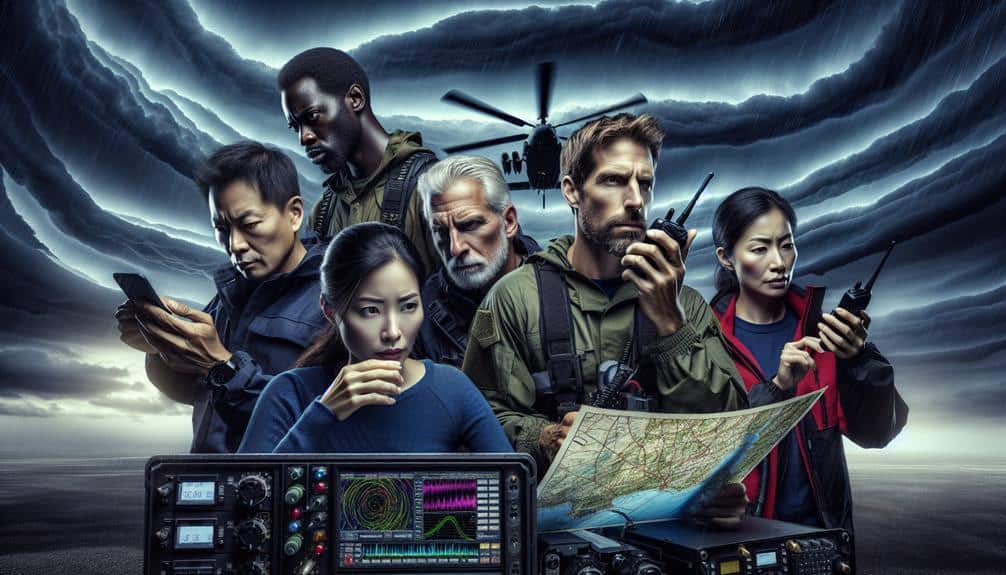
As storm chasers, we must prioritize accurate information to guarantee safety and effectiveness.
We need to verify data sources rigorously, avoid making misleading statements, and provide timely updates.
Verify Data Sources
Validating the accuracy of our data sources is crucial for effective and safe storm chasing. To achieve this, we must prioritize data validation and credibility. Reliable information allows us to make informed decisions, enhancing our safety and the precision of our communications.
Source authentication is essential to determine the reliability of the data we use. We should integrate a robust system to vet our data sources:
- Cross-reference multiple data points: Compare information from various reputable sources to confirm its accuracy.
- Utilize established meteorological institutions: Rely on data from respected organizations like the National Weather Service or NOAA.
- Regularly update source lists: Keep an updated roster of trusted sources to ensure we're always using the most dependable information.
Avoid Misleading Statements
We must prioritize accurate information to avoid misleading statements, guaranteeing the credibility and effectiveness of our communications.
In the field of storm chasing, ethical reporting is crucial. We hold a responsibility to provide truthful updates that our audience can rely on. This commitment to transparency not only builds trust but also upholds our accountability to the public.
When we disseminate information, we must thoroughly verify our data to avoid inaccuracies. Misleading statements can cause unnecessary panic or, conversely, a false sense of security. Both scenarios can have serious consequences for those relying on our updates. Therefore, clarity and precision in our communication are essential.
Moreover, we need to be vigilant about the language we use. Ambiguous terms or sensational language can distort the reality of the situation. Instead, we should use specific and verifiable details to describe storm conditions. This approach guarantees that our audience receives a clear and accurate picture, enabling them to make informed decisions.
Timely Updates Required
Providing timely updates during storm events is essential to maintaining the accuracy and reliability of the information we deliver. Our commitment to real-time data helps establish protocols that guarantee both our safety and the safety of others. In the dynamic environment of storm chasing, every second counts, and delays can make the difference between a safe operation and a hazardous one.
To enhance safety and secure our updates are both timely and accurate, we need to:
- Use reliable communication tools: Ensure all devices are fully charged and have backup power sources.
- Establish clear protocols: Define who's responsible for updates and how frequently they should be communicated.
- Monitor multiple information sources: Cross-reference data from weather services, radar, and on-ground observations.
Maintain Regular Updates
To enhance safety and coordination, storm chasers must consistently relay their position and status to their team and relevant authorities. This practice guarantees that everyone involved in weather tracking and emergency response is fully aware of our current conditions and location. By maintaining regular updates, we create a dynamic flow of information that can be essential for making real-time decisions.
We should leverage multiple communication channels, such as radio, satellite phones, and internet-based systems, to guarantee redundancy. Using GPS-enabled devices allows us to transmit our exact coordinates, which is crucial for precise weather tracking. This data helps meteorologists update models and forecasts, ultimately aiding emergency response teams in planning and executing their strategies.
Regular updates also allow us to quickly adapt to changing conditions. By consistently sharing information, we enable our team to anticipate potential hazards and adjust our course accordingly. This minimizes risks and maximizes the effectiveness of our mission.
Coordinate With Local Authorities
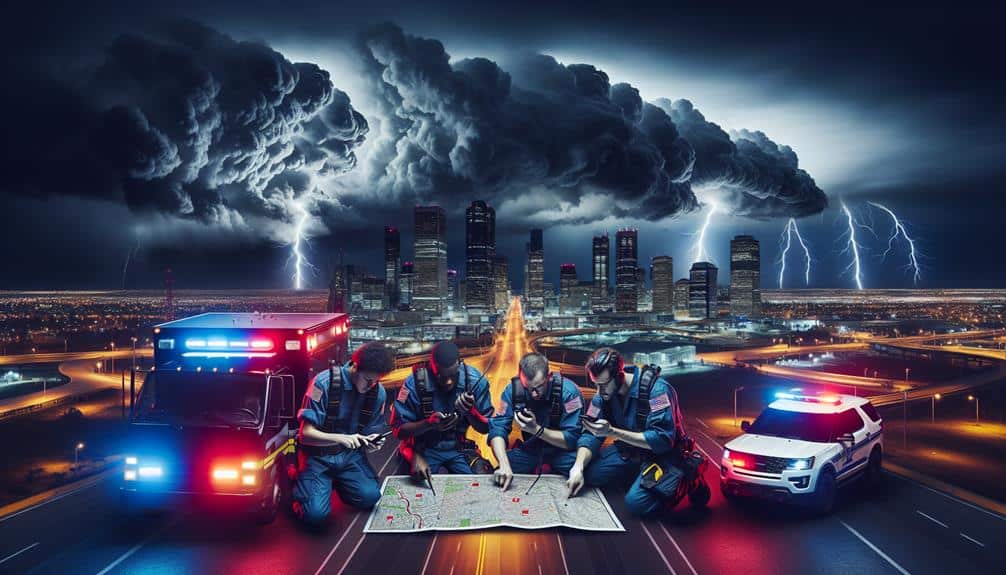
Establishing a direct line of communication with local authorities guarantees that storm chasers can swiftly relay critical information and receive essential updates. By coordinating with emergency response teams, we guarantee that our efforts contribute to effective disaster management. Direct communication channels enable us to share real-time observations that can aid in public safety measures.
When coordinating with local authorities, we should:
- Register with emergency management agencies: Make sure they know our location and intentions, which helps in orchestrating a unified response during severe weather events.
- Share real-time data: Provide authorities with accurate and timely information about storm developments, which can be critical for issuing warnings and coordinating evacuations.
- Adhere to local protocols: Follow any guidelines or directives issued by local authorities to avoid hindering emergency response operations.
These steps not only enhance the efficiency of our storm-chasing activities but also guarantee we're contributing positively to disaster management efforts. By working closely with local authorities, we can help safeguard communities while pursuing our passion for storm chasing.
Prepare for Signal Loss
We must anticipate and plan for potential signal loss by using multiple communication channels and backup systems. In storm-chasing scenarios, cellular networks can become unreliable due to adverse weather conditions. To mitigate this, we should integrate satellite phones into our communication arsenal. Satellite phones offer a more reliable connection when terrestrial networks fail.
Our backup plans should also include using two-way radios. These radios, especially those with extended range capabilities, ensure we stay in touch with our team even when conventional networks are down. It's vital to pre-program these devices with the necessary frequencies and conduct routine checks before heading out.
Moreover, we should establish a network of emergency contacts. These contacts act as our lifeline during signal loss, allowing us to relay important information indirectly. We must share our planned routes, estimated timelines, and contingency plans with these contacts to facilitate efficient coordination.
Understand Emergency Protocols
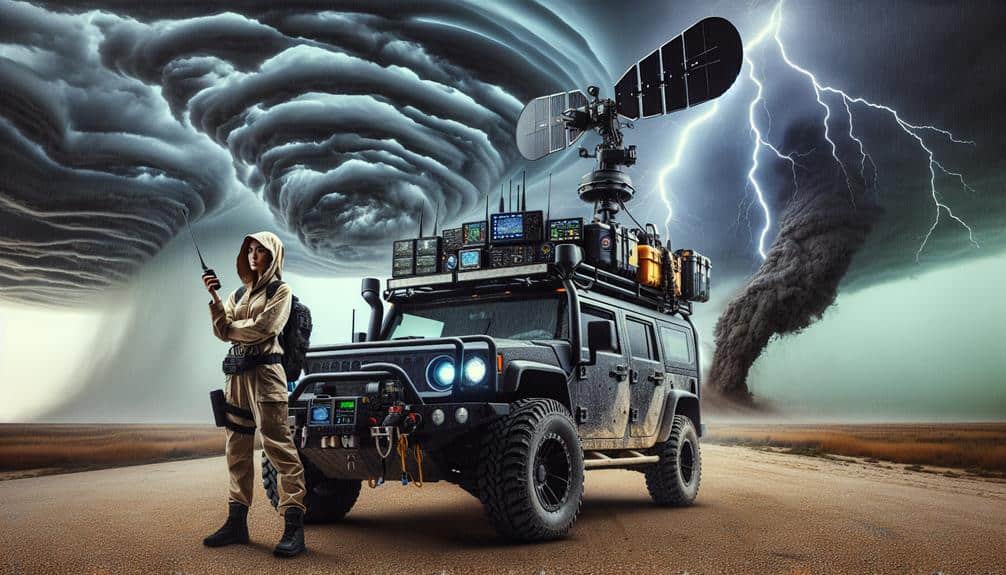
Understanding emergency protocols is crucial for securing our safety and effective coordination during storm-chasing missions. We need to be prepared for any scenario, and this means having robust emergency response plans and clear communication strategies in place.
First, let's prioritize the following:
- Know Local Emergency Management: Familiarize ourselves with the local emergency management agencies and their protocols.
- Standardized Communication Codes: Use standardized codes and terminology to minimize confusion during critical moments.
- Emergency Contact List: Maintain an up-to-date list of emergency contacts, including local authorities and fellow storm chasers.
Frequently Asked Questions
How Can Storm Chasers Ensure Their Personal Safety While Communicating?
We're sailing through a storm's chaos, so let's anchor our safety with solid communication protocols. Implementing stringent safety measures, effective risk management, and a robust emergency response guarantees we can chase storms without jeopardizing our freedom or well-being.
What Are the Best Practices for Storm Chasers to Avoid Misinformation?
We verify data meticulously to avoid misinformation. Fact-checking is essential before information sharing. We cross-reference multiple sources and use reliable tools to guarantee accuracy, empowering us to share correct details while maintaining our freedom to operate effectively.
How Should Storm Chasers Handle Conflicting Reports From Multiple Sources?
Given that 80% of storm reports can contain inaccuracies, we must prioritize data verification and source credibility. Let's apply critical thinking to guarantee consistency, cross-checking multiple sources before disseminating any information to maintain reliable updates.
What Role Does Social Media Play in Storm Chaser Communication?
Social media enhances our online presence and engagement. It facilitates rapid information sharing and collaboration among storm chasers, ensuring accurate, real-time updates. This interconnectedness empowers us to make informed decisions and maintain operational freedom.
How Can Storm Chasers Effectively Communicate With Non-Professionals During a Storm?
When the storm roars like a lion, our public outreach becomes a lifeline. We engage the community through clear, timely updates and use visual aids to guarantee accurate, actionable information reaches everyone swiftly, fostering informed, independent decisions.
